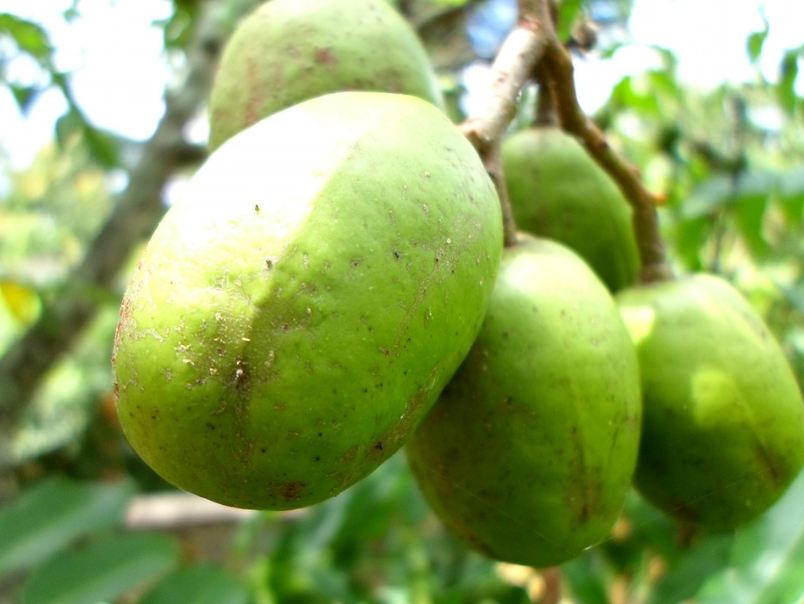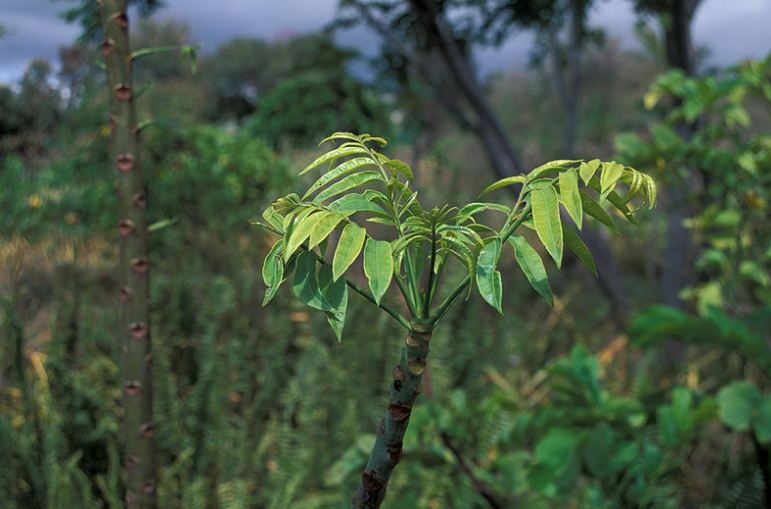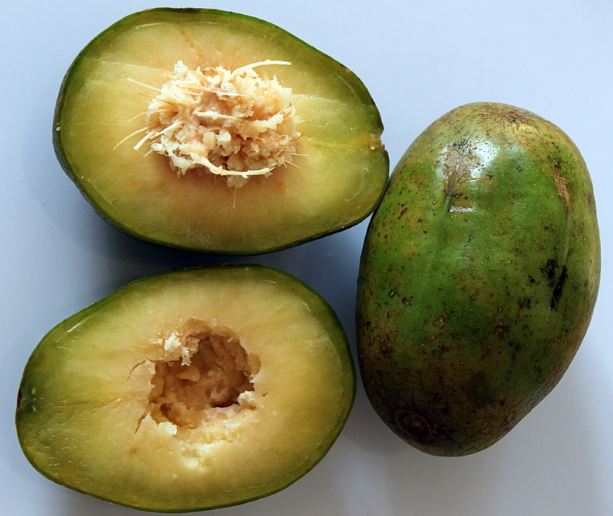Ambarella belongs to the Anacardiaceous family, which also contains mangoes and cashews. It is biologically named SpondiasDulcis and is a tropical tree with an edible fruit containing a stringy pit.
With several uses and benefits, Ambarella is one great plant to place in your own garden. Let’s have a look at everything about it below!
Features and Distribution of Ambarella
Known by several other names like Amra Kai, June Plum, Mangotin, Golden Apple, Ambade, Dwarf Golden Plum, Ambarella is a fast-growing tree reaching up to 20m in its local range Melanesia and Polynesia. However, it grows to almost 12m in other areas. It has pinnate leaves with numerous tiny, glossy leaflets that tend to fall off at maturity. Dainty white flowers grow on these trees called panicles, which eventually turn into green oval-shaped fruits. These fruits grow in bunches of 12 or more on one long stalk and fall to the ground when green and hard but turn yellow gold in color as they ripen.
In Hawaii, the fruit matures from November to April; in Tahiti, from May to July. In Florida, a solitary tree provides a consistent inventory to families from fall to midwinter, when numerous mainstream natural products, including mangoes, are unavailable. The fruit tastes juicy and mildly acidic similar to mangoes and pineapples. Due to its resourcefulness, SpondiasDulcis is now cultivated in tropical zones across the world. It was brought to Jamaica in 1782 and is now grown in various areas, including Panama, Cuba, Haiti, and other regions with an equatorial climate that is hot and wet all year round. The United states department of agriculture also tried cultivating these trees in 1909, but it was quite unpopular due to the weather conditions.
Health Benefits of Ambarella
This delicious tropical fruit is loaded with vitamins, antioxidants, and fiber. All these nutrients are a point of interest for human wellbeing; their benefits include: enhancing the immune system, preventing heart problems, enriching skin texture, improving vision, and promoting the digestive system. Below we have listed some of the countless extensive benefits of this delicious yet under-appreciated fruit:
- Treats Cough
Put three to four ambarella leaves in two cups of water and boil it for a few minutes. You can add some salt or honey to flavor it. Once it is prepared, let it sit for a while before drinking. Consuming ambarella tea thrice a day can prove very beneficial in treating cough and sore throat.
- Improves Skin Texture
Ambarella is rich in vitamin C, which helps repair and nourish skin tissues and protect them against harmful ultraviolet rays and free radicals. Skincare companies add ambarella extract in moisturizers to utilize its benefits. In ancient times, they have also been used as a substitute for body lotions, while their roots were used to treat itchy skin.
- Promotes Digestion
Rich in dietary fiber, the pulp of this fruit is quite effective in treating constipation and indigestion. It also helps in preventing dehydration because of its high water content. The bark is boiled in water and consumed by diarrhea patients to ease discomfort and alleviate constipation.
- Helps in Weight Loss
Having high fiber content and low carbohydrates and fat content, ambarella is very useful for weight loss purposes. The high water content gives the feeling of fullness and prevents overeating, making it a superfood for those trying to lose some pounds. It can be eaten as a fruit or added to curry recipes.
- Strengthens the immune system
You can use unripe ambarella to make pickles as they have a high iron content and work wonders for the immune system. Iron, along with vitamin C, promotes white blood cell production and prevents anemia and fatigue.
Other than the above-listed health benefits, consuming ambarella can profit you in numerous ways. People also use their leaves, bark, roots, flowers, and fruits themselves. It helps heal wounds, controls cholesterol levels, boosts bone strength, increases endurance, and the list goes on.
How to Grow Ambarella
Ambarella is a low-maintenance plant and doesn’t require much effort. However, to plant the ambarella tree, you need to consider the following two factors:
Climate
The best climate for ambarella is hot and wet: a characteristic feature of tropical regions. It has a low frost and drought tolerance. It is best to grow SpondiasDulcis in a sheltered environment as they are sensitive to wind storms. In a suitable climate, seedlings may start bearing fruit just after four years.
Soil
Any soil works fine for ambarella as long as it is well-drained. In fact, it even thrives in Florida, where limestone soil is used.
Propagating the Ambarella Plant
Slightly soak the soil depending on the weather conditions. Ensure not to overwater it as that will end up causing the tree to decay. You will have to keep a check on the water level: when the top two inches become dry, water the tree. It is best to keep weeds at least one meter away from the tree. After selecting an appropriate spot, dig holes of 2 feet in width and height. Now put in the seeds and backfill the holes with soil. You can add fertilizers or pesticides if needed. It takes about four weeks for the seeds to germinate. You can also propagate the ambarella tree by cutting large hardwood or by air layers.
Harvesting the Ambarella Fruit
Harvest the fruit when it turns green; however, some prefer to harvest the ripped fruit when its color changes to yellow gold with a hard pit. The perfect ambarella is the one that looks glossy with no signs of bruises. However, it is common to have a few dark spots. It has a pleasant tropical kind of aroma, which might also turn into a little musky at peak ripeness.
How to Consume Ambarella Fruit
People prefer storing the fruit for almost two weeks after harvesting to enhance its taste as they do to mangoes. Chilling the fruit diminishes the flavor, which is also why transport to far-off places is unfeasible. You can incorporate the ambarella fruit in numerous recipes. If you are bored of eating the fruit, you can consume it in the following ways:
- Ambarella Jams
- Ambarella Juices
- Ambarella Jellies
- Ambarella Chutney
- Ambarella Curry
- Ambarella Pickle
- Ambarella Candy
The Takeaway
In conclusion, ambarella is rich in nutrients and provides a myriad of health benefits, from improving digestion to boosting the immune system. It is a superfood for those on a weight loss diet and those looking to substitute medicines with a natural supplement. It is safe to say that ambarella is a treasure, though an underrated one. So, what are you waiting for? Plant the ambarella tree today and take advantage of its countless benefits!



